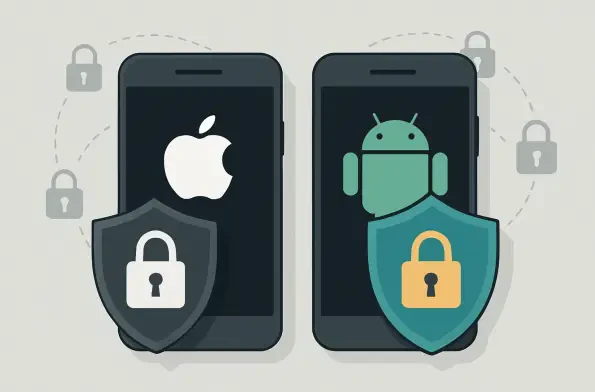Introduction to iOS and Android Security Frameworks
In an era where mobile devices store everything from personal photos to sensitive financial data, the security of these platforms has become a critical concern, with over 80% of the global population relying on smartphones for daily tasks, making them integral to both personal and professional lives. Both iOS, developed by Apple, and Android, backed by Google, dominate the mobile operating system market, powering billions of devices in personal and enterprise settings. Their widespread adoption makes them prime targets for cybercriminals, raising the stakes for robust security measures to protect user privacy and device integrity.
The significance of security in mobile platforms cannot be overstated, as these systems must safeguard against an ever-evolving landscape of cyber threats, including malware, phishing, and sophisticated spyware. Ensuring data protection and maintaining trust are paramount, especially as mobile devices become integral to business operations and personal communication. Both platforms face unique challenges in addressing these risks, shaped by their distinct design philosophies and operational models.
At the core of their differences lies Apple’s closed ecosystem, which emphasizes tight control over hardware and software, contrasting with Android’s open-source nature that fosters flexibility and customization. This fundamental divergence influences how each platform approaches security, from app distribution to system updates. The following analysis delves into these differences, providing a comprehensive comparison to understand their strengths and vulnerabilities in protecting users.
Core Security Features: A Head-to-Head Comparison
System Architecture and Sandboxing Mechanisms
The foundation of iOS security rests on a closed-system architecture, where Apple maintains strict oversight over both hardware and software integration. This design limits external interference and enforces a uniform security model across all devices, with sandboxing mechanisms that isolate apps to prevent unauthorized access to system resources or other applications. Such rigidity minimizes the risk of exploits by ensuring that even compromised apps have limited impact on the broader system.
In contrast, Android operates on an open-source framework, allowing manufacturers and developers greater freedom to modify the operating system. While this flexibility enables innovation, it also introduces variability in security implementations across devices. Android’s sandboxing relies on app permission models that have evolved significantly in recent years, granting users more granular control over data access, though inconsistencies in enforcement across different versions and devices can create potential loopholes for malicious actors.
A clear distinction emerges in how these approaches impact security outcomes. For instance, iOS’s uniform architecture prevents apps from interacting with core system files without explicit approval, while Android’s model, though improved with features like scoped storage, still faces challenges from legacy apps or third-party modifications that may bypass restrictions. This comparison highlights a trade-off between control and adaptability in securing mobile environments.
App Ecosystem and Vetting Processes
Apple’s App Store operates under a stringent vetting process, where every application undergoes rigorous review before publication, adhering to strict developer guidelines. This closed ecosystem significantly reduces the likelihood of malicious software reaching users, as sideloading—installing apps outside the official store—is heavily restricted on iOS devices. The result is a curated environment that prioritizes user safety over openness.
On the other hand, the Google Play Store, while implementing its own review mechanisms, adopts a more permissive stance, allowing a broader range of apps and developers to participate. Additionally, Android supports sideloading, enabling users to install applications from third-party sources, which, while beneficial for flexibility, increases exposure to unverified or harmful software. This openness can lead to a higher incidence of malware, especially in regions with less regulated app markets.
The impact of these differing philosophies is evident in user risk profiles. Apple’s controlled approach offers a safer default experience, though it may limit app diversity, whereas Android’s ecosystem provides more choice at the cost of requiring greater user vigilance. Both platforms strive to balance accessibility with protection, but their methods reflect contrasting priorities in managing app-related threats.
Update Delivery and Vulnerability Patching
Apple’s direct control over iOS hardware and software enables swift and consistent delivery of security updates across its device lineup. This centralized model ensures that patches for vulnerabilities are rolled out promptly, often within days of identification, minimizing the window of exposure for users. High adoption rates for the latest iOS versions further strengthen this defense, as most devices receive updates simultaneously.
Android, however, operates within a fragmented ecosystem where updates depend on device manufacturers and carriers, leading to significant delays in patch distribution. Many devices, especially older or budget models, may never receive the latest security fixes, leaving them vulnerable to known exploits. Statistics indicate that a substantial portion of Android devices run outdated versions, amplifying risks in a landscape where timely updates are critical.
The implications of these update mechanisms are profound for user security. Apple’s streamlined process offers a clear advantage in addressing zero-day threats, as seen in rapid responses to high-profile vulnerabilities. Conversely, Android’s inconsistent rollout has occasionally resulted in prolonged exposure to risks, underscoring a structural challenge that continues to affect its security posture despite Google’s efforts to improve update delivery through initiatives like Project Mainline.
Challenges and Limitations in Security Implementation
The iOS platform, while renowned for its robust security, grapples with challenges stemming from its restrictive nature. Limited user customization options can frustrate those seeking greater control over their devices, sometimes prompting risky behaviors like jailbreaking that undermine built-in protections. Additionally, recent rollouts of advanced features, such as Memory Integrity Enforcement, have faced scrutiny over transparency, with concerns about how much information is shared regarding their implementation and impact.
Android faces distinct hurdles due to its fragmented ecosystem, where inconsistent update rollouts across manufacturers create disparities in security levels among devices. The openness that defines Android also heightens exposure to malware, particularly through sideloading and third-party app stores that may host unverified content. This structural diversity, while a strength for innovation, often complicates efforts to maintain a uniform defense against emerging threats.
Both platforms must contend with the growing sophistication of cyberattacks, such as zero-day exploits that can bypass even the most advanced safeguards. The need for user education remains a critical factor, as even the strongest technical measures can be undermined by poor practices like downloading untrusted apps or ignoring update prompts. Addressing these shared challenges requires not only technological advancements but also a commitment to empowering users with knowledge to navigate an increasingly complex digital environment.
Conclusion: Which Platform Offers Stronger Security?
Reflecting on the comparison, it becomes clear that iOS and Android embody distinct security philosophies, with Apple’s closed ecosystem delivering tighter control and faster update cycles, while Android’s open-source model prioritizes flexibility at the expense of consistency. The strengths of iOS lie in its uniform architecture and rigorous app vetting, whereas Android excels in offering customization, albeit with greater responsibility placed on users to secure their devices. Each platform reveals vulnerabilities—iOS through limited transparency and user control, and Android via fragmentation and malware exposure.
Looking back, a balanced perspective emerges for users deciding between the two based on their priorities. For those who value out-of-the-box security and privacy with minimal effort, iOS stands as the preferable choice, while Android caters to individuals willing to invest in additional safeguards for the sake of versatility. Tailoring the choice to specific needs, such as enterprise environments favoring iOS or tech enthusiasts opting for Android, proves essential in maximizing protection.
Moving forward, both platforms are poised to evolve with innovations like Apple’s Memory Integrity Enforcement setting new benchmarks and Android’s ongoing efforts to streamline updates promising improvement. A key takeaway is the importance of staying proactive—users are encouraged to keep software current, scrutinize app sources, and adopt best practices to complement built-in defenses. As cyber threats continue to advance, fostering collaboration between developers, manufacturers, and users emerges as a vital step toward enhancing mobile security standards across the board.













